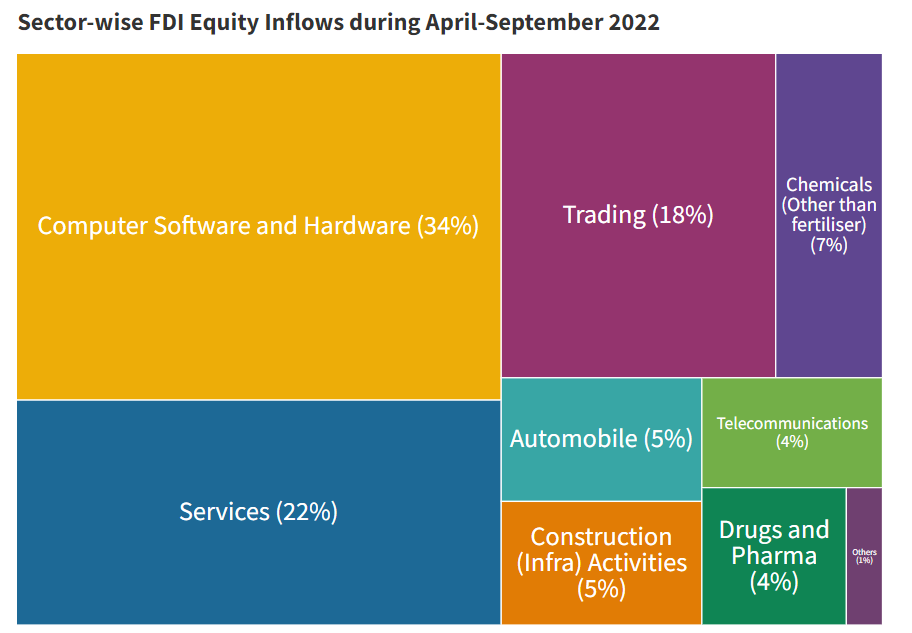Foreign Direct Investment Inflows | 26 May 2023
For Prelims: Foreign Direct Investment (FDI), Department for Promotion of Industry and Internal Trade (DPIIT), World Investment Report, Intellectual property rights.
For Mains: Trends and Patterns of FDI Inflows in India, Challenges Related to FDI inflows in India
Why in News?
Foreign Direct Investment (FDI) inflows into India have experienced a notable downturn in the fiscal year ending March 2023.
- FDI inflows on a gross basis stood at USD 71 billion in FY23, reflecting a decline of 16% compared to the previous fiscal year, marking the first decrease in FDI inflows in the country in the past decade.
What is Foreign Direct Investment (FDI)?
- Foreign direct investment (FDI) is a type of cross-border investment in which an investor from one country establishes a lasting interest in an enterprise in another country.
- FDI can take various forms, such as acquiring shares, establishing a subsidiary or a joint venture, or providing loans or technology transfers.
- FDI is considered to be a key driver of economic growth, as it can bring in capital, technology, skills, market access and employment opportunities to the host country.
What are the Trends and Patterns of FDI Inflows in India?
- About:
- India has been one of the most attractive destinations for FDI in recent years, owing to its large and growing domestic market, favourable demographics, political stability, liberalised policy framework and improved ease of doing business.
- According to the Department for Promotion of Industry and Internal Trade (DPIIT), India’s cumulative FDI inflow stood at USD 871.01 billion between April 2000-June 2022.
- According to the World Investment Report 2022, India has ranked 7th among the top 20 host economies for 2021.
- India received the highest-ever FDI inflows of USD 84.8 billion including USD 7.1 billion FDI equity inflows in the services sector in FY22.
- Country-wise FDI Equity Inflow FY-2021-22:
- Singapore (27.01%), USA (17.94%), Mauritius (15.98%), Netherland (7.86%) and Switzerland (7.31%) emerge as top 5 countries for FDI equity inflows.
What are the Challenges Related to FDI inflows in India?
- Taxation and Regulatory Compliance: India's tax regime has undergone several reforms in recent years, but complexities and uncertainties still exist.
- Frequent changes in tax laws, multiple layers of taxation, and disputes over tax assessments create challenges for foreign investors in terms of compliance and tax planning.
- Competition from Other Emerging Markets: India faces competition from other emerging markets, such as China, Vietnam, and Indonesia, in attracting FDI.
- These countries offer competitive advantages, including lower costs of production, better infrastructure, and more investor-friendly policies.
- Infrastructure Deficit: Despite ongoing efforts to improve infrastructure, India still faces significant gaps in areas such as transportation, logistics, power, and telecommunications.
- Insufficient infrastructure hampers the ease of doing business and raises operational costs for foreign investors.
What Measures can be Taken to Boost FDI Inflows in India?
- Simplify and Streamline Regulatory Processes: India can further simplify and streamline its regulatory processes, including licensing, permits, and approvals. Implementing a single-window clearance system or a digital platform for regulatory compliance can reduce bureaucracy and enhance the ease of doing business.
- Improve Infrastructure Development: Focus on improving infrastructure across sectors such as transportation, logistics, power, and digital connectivity.
- Developing world-class infrastructure facilities and industrial clusters will attract foreign investors looking for efficient and well-connected business environments.
- Enhance Investor Protection Mechanisms: Strengthening investor protection mechanisms, including robust intellectual property rights (IPR) enforcement, contract enforcement, and dispute resolution mechanisms, will instil confidence in foreign investors.
- This can be achieved through judicial reforms, specialised commercial courts, and alternative dispute resolution methods.
- Promote Sector-Specific Investment Policies: Formulate sector-specific investment policies and incentives to attract FDI in key sectors such as manufacturing, renewable energy, healthcare, technology, and e-commerce.
- Tailoring policies to address the specific needs and requirements of each sector can encourage foreign investors to invest in those areas.
UPSC Civil Services Examination, Previous Year Questions (PYQs)
Q. With reference to Foreign Direct Investment in India, which one of the following is considered its major characteristic? (2020)
(a) It is the investment through capital instruments essentially in a listed company.
(b) It is a largely non-debt creating capital flow.
(c) It is the investment which involves debt-servicing.
(d) It is the investment made by foreign institutional investors in Government securities.
Ans: (b)
Q. Consider the following: (2021)
- Foreign currency convertible bonds
- Foreign institutional investment with certain conditions
- Global depository receipts
- Non-resident external deposits
Which of the above can be included in Foreign Direct Investments?
(a) 1, 2 and 3
(b) 3 only
(c) 2 and 4
(d) 1 and 4
Ans: (a)
Q. Consider the following:
- Foreign currency convertible bonds
- Foreign institutional investment with certain conditions
- Global depository receipts
- Non-resident external deposits
Which of the above can be included in Foreign Direct Investments?
(a) 1, 2 and 3
(b) 3 only
(c) 2 and 4
(d) 1 and 4
Ans: (a)

